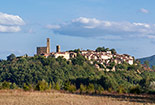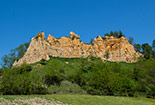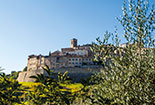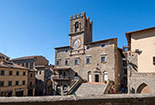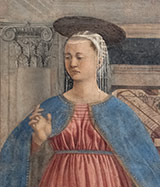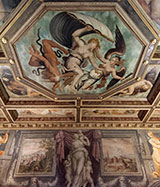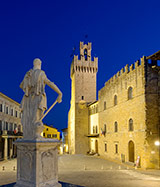Arezzo
tuscan art city that you can know in every detail with this website
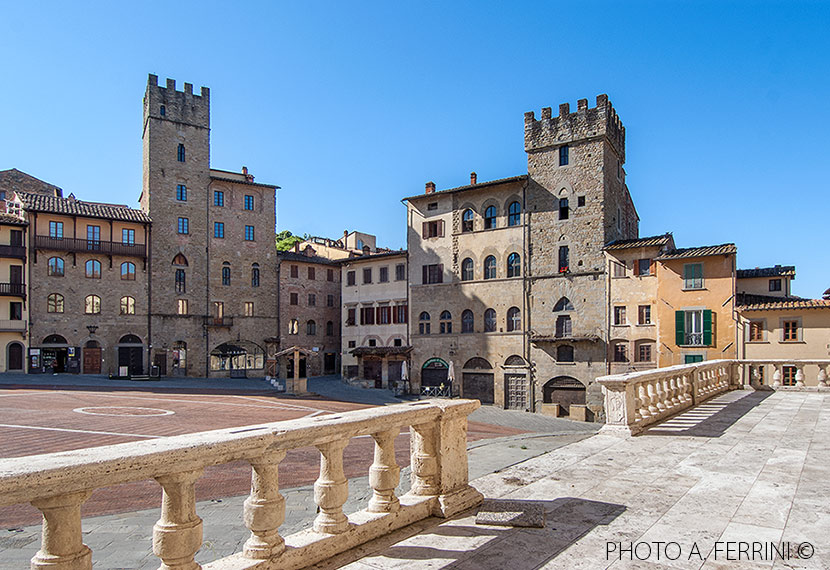
Texts and photos by Alessandro Ferrini ©
128 accurately described images of Arezzo. Click to enlarge
Arezzo, geographical position and origins
Arezzo is a city of art with an ancient history located in the eastern part of Tuscany, the ancient Etruria, then Tuscia.
It still preserves most of the medieval walls, and then Medici, which encircled it with integrated into these large gates.
Arezzo, which today has about one hundred thousand inhabitants, is located on a hill 290 meters above sea level. At the top of this are the Town Hall, the ancient Medici Fortress, the Cathedral. The latter, for its elevated position where it is located, for its Gothic style projected towards the sky and for its very high bell tower, is clearly visible from the green countryside surrounding the city, also strikes the attention of those who arrive in Arezzo from three of the four valleys that make up the territory of the province of Arezzo: the Casentino, the Valdarno, the Val di Chiana. The first of these valleys, of Dante's memory, is known for its castles and medieval churches, towns like Bibbiena, Poppi, Pratovecchio, for spiritual places like La Verna and Camaldoli immersed in the National Park of the Casentino Forests. In Valdarno there are interesting towns such as Montevarchi, San Giovanni, Terranuova Bracciolini, Loro Ciuffenna. In addition, this valley is known for its characteristic crags, gigantic clay "sculptures" already the subject of study of Leonardo. The Valdichiana is remembered for countries of very ancient origin. First of all the Etruscan Cortona, but interesting are also Castiglion Fiorentino, Foiano, Monte San Savino and Lucignano.
These three valleys meet and meet a few kilometers from Arezzo, in Ponte Buriano, a wonderful example of Romanesque architecture on the Arno. A work that also caught the attention of Leonardo da Vinci, it seems that this is the bridge that in great Renaissance painter and scientist depicts in the background of his famous Mona Lisa.
The fourth valley that is part of the territory of the Province of Arezzo is the Valtiberina. This land, consisting of the upper Tiber valley, remains further away from the city. Its most famous centers are Anghiari, Monterchi, Caprese Michelangelo, Sansepolcro, Pieve Santo Stefano, Città di Castello, Citerna, the latter two in Umbria.  The climate of Arezzo and its surroundings can be defined as "typical of hilly Tuscany". Certain crops present, such as the vine, the olive tree, the cereals, the orchards of the Val di Chiana, "certify it. Since Arezzo is practically at the centre of the "Italian boot", it is not affected by a maritime climate. It is commonly said that the history of Arezzo begins with the Etruscans. This is certainly and unequivocally true given the numerous finds of various kinds inherent in this ancient Italic civilization found in the area, first of all a large necropolis dating from the sixth century B.C. But settlements in the area of Arezzo existed well before the Etruscans, proof of which are the archaeological finds of the prehistoric age of which the most famous and extraordinary is the "Uomo dell’Olmo".
The climate of Arezzo and its surroundings can be defined as "typical of hilly Tuscany". Certain crops present, such as the vine, the olive tree, the cereals, the orchards of the Val di Chiana, "certify it. Since Arezzo is practically at the centre of the "Italian boot", it is not affected by a maritime climate. It is commonly said that the history of Arezzo begins with the Etruscans. This is certainly and unequivocally true given the numerous finds of various kinds inherent in this ancient Italic civilization found in the area, first of all a large necropolis dating from the sixth century B.C. But settlements in the area of Arezzo existed well before the Etruscans, proof of which are the archaeological finds of the prehistoric age of which the most famous and extraordinary is the "Uomo dell’Olmo".
The etruscan period
Returning to the Etruscans, the settlement was located where now is the oldest part of the city and is dated VII - VI century b.C. - The Etruscans are responsible for the origin of the name from the city: Aritim (which the Romans later transformed into Arretium). Symbol of Etruscan Arezzo, but still today an unequivocal symbol of the city, is a work of art in bronze found centuries ago: the Chimera, a monster of Greek mythology with the body and head of a lion, a snake in place of the tail and a goat's head on his back. This extraordinary discovery took place in 1553, in the middle of the Tuscan Grand Duchy period, during the consolidation works of the defensive perimeter walls of Arezzo commissioned by the Grand Duchy of Tuscany itself. Arezzo, Archaeological Museum For this reason, and because the city belongs to the Ganducato, the bronze sculpture was immediately  brought to Florence at the behest of Cosimo I dei Medici. It is here since the hour remained and today is kept in the Archaeological Museum of the Tuscan capital. For the people of Arezzo, and visitors to Arezzo, an identical copy of it is on display in the gardens in front of the train station. Another smaller copy can be found inside the Porta di San Lorentino. This is because it was here that it was found. The Chimera is certainly a work of the Etruscan period, but some have raised doubts that it is not made Etruscan, but Greek on an Etruscan commission. This is for two reasons: for what the Chimera represents, because the Greek civilization was much ahead in the realization of works so harmonious and refined.
brought to Florence at the behest of Cosimo I dei Medici. It is here since the hour remained and today is kept in the Archaeological Museum of the Tuscan capital. For the people of Arezzo, and visitors to Arezzo, an identical copy of it is on display in the gardens in front of the train station. Another smaller copy can be found inside the Porta di San Lorentino. This is because it was here that it was found. The Chimera is certainly a work of the Etruscan period, but some have raised doubts that it is not made Etruscan, but Greek on an Etruscan commission. This is for two reasons: for what the Chimera represents, because the Greek civilization was much ahead in the realization of works so harmonious and refined.
Already in the Etruscan period were active, near Arezzo, small mines of iron and various minerals. This, together with the agricultural and handicraft production, as well as the commercial skills of the people, made the Etruscan settlement one of the richest in existence. For this wealth Aritim was one of the twelve "lucomonie" Etruscan, that is, the seat of a judiciary with royal power.
The roman period
Arezzo also played an important role in the history of Rome and its empire. The main reason for this was that the lands of Arezzo were located along an important route that led from Rome to the north: the Via Cassia.
Arezzo was conquered by the Romans and the Etruscans in the third century BC. If at the beginning Arezzo represented a bridge, a stopping point, of the movements of the Romans towards the north, later the Tuscan city became an important Roman garrison on the territory.
Arezzo witnessed the passage of the great and powerful Carthaginian army, led by Hannibal, which ran through Italy from north to south during the second Punic war. It seems that Hannibal, from the heights of Pratomagno, had spied on and studied the movements of the Roman troops that were in the plain of Arezzo, and then went to defeat them heavily, with a masterpiece of war strategy, in the famous battle of Trasimeno in 217 B.C.  Arezzo, Roman Amphitheatre In the Roman period part of this craft was converted into workshops for the manufacture of weapons, so "Arretium" became an important supplier of weapons to the Roman Empire, this was synonymous with wealth.
Arezzo, Roman Amphitheatre In the Roman period part of this craft was converted into workshops for the manufacture of weapons, so "Arretium" became an important supplier of weapons to the Roman Empire, this was synonymous with wealth.
Another source of wealth for Arezzo in Roman times was ceramics. The vases and other objects made of this material became known and spread in many places of the Roman Empire. This art-craftsmanship of ceramics had certainly begun in Arezzo during the Etruscan period (the finely decorated Etruscan vases are well known). With the Roman period this profession was refined, but more than anything else it increased productivity because the ceramics of Arretium became known and therefore requested. What we call "export" begins.
When Arezzo became an important garrison in Rome, many Romans became settled in this place, hence the need to create works for their needs. Among these, a large amphitheatre (2nd century A.D.) whose remains, still well erected, have survived to the present day. This work is the most evident evidence of the Roman presence in Arezzo.
The post-roman and feudal period
The period of decadence of the Roman Empire and the centuries of barbarian invasions were relatively decadent years for Arezzo compared to other places. This is because, as already mentioned, the city was along a road network of particular importance and because it was a rich area, monetarily and also of artisan and entrepreneurial ability.
Arezzo and a vast surrounding area were for many decades on the borderline between the territories under Byzantine rule, to the south, and those occupied by the northern populations of the Goths and Lombards. This is testified by the presence, in the same areas, of churches dedicated to St. Michael the Archangel, protector of the Lombards, and others dedicated to St. Apollinare, protector of the Byzantines. It was the Lombards, once conquered Arezzo, to begin the work of Arezzo, Palazzo Comunale fortification and lay the foundations of medieval Arezzo that today largely presents itself to us. In medieval times were built several walls of the city, what was believed to be the final was completed in the third decade of the '300. Instead, in the mid-16th century, Cosimo I dei Medici would have made profound changes and reinforcements to the defensive structure of Arezzo.
It was the Lombards, once conquered Arezzo, to begin the work of Arezzo, Palazzo Comunale fortification and lay the foundations of medieval Arezzo that today largely presents itself to us. In medieval times were built several walls of the city, what was believed to be the final was completed in the third decade of the '300. Instead, in the mid-16th century, Cosimo I dei Medici would have made profound changes and reinforcements to the defensive structure of Arezzo.
The years of feudalism were in Arezzo, as in other important places, a period of continuous conflict between the feudal power (in Arezzo assigned to the bishop) and the population. The various successive bishops exercised a very totalitarian power. However, the merit of having succeeded in restoring order, morality and new stimuli to a territory that had come out quite "barbaric" from the previous centuries must be acknowledged. In agreement with the emperor, they started the foundation of various abbeys in the territory of Arezzo, in order to better control it from a religious, political, economic and cultural point of view. The first, and of great importance, were the Abbey of Santa Trinita in Alpe in the Municipality of Talla and the Abbey of Campoleone in Castelluccio di Capolona.
From the communal age to submission to Florence
The second half of the 11th century was a period of profound change in the economic, social and political history of Arezzo. The feudal power of the bishop is superimposed on the power of the citizens: we are at the birth of the City, whose power will become stronger and more effective during the twelfth century. Coming out of feudalism and the advent of the Commune meant for Arezzo, but also for any other city, new vitality, new creative and entrepreneurial spirit.
In the thirteenth century Arezzo I gave a personal definition: the beginning of the "present history" of Arezzo. In practice begins that story that today we can read in detail not only in written documents, but also in "architectural documents", in "pictorial documents" or art of other kinds. Arezzo began to model itself and today, precisely because of its architectural and artistic forms,  it has become a Tuscan city of art known throughout the world.
it has become a Tuscan city of art known throughout the world.
Arezzo, Pieve di Santa MariaFin from the communal era there had been continuous political and territorial conflicts between Arezzo and Florence. These struggles reached their peak with the famous and epic Battle of Campaldino of June 11, 1289, when the Ghibellines of Arezzo were heavily defeated by the Florentine Guelphs (alongside the latter also fights Dante Alighieri. A model showing this battle in detail is exhibited in the Castle of Poppi). This event decreed the submission of Arezzo to the Florentine Republic. Autonomous, but subdued, a strange political situation for Arezzo that with the election as Bishop, in 1312, of a great personality like Guido Tarlati (his brother Piero was Lord of Bibbiena in Casentino), suffered a sort of rebirth, of new prosperity. With Bishop Tarlati there were territorial conquests and the last medieval walls were started, which would have ended in 1337.
With the death of Guido Tarlati, Arezzo restarted towards a phase of decline that culminated in 1384 with the real sale of the city to the Florentine Republic.
The Florentine period
For Arezzo, as for other places, being subjugated and "owned" by Florence meant a loss of political, economic and cultural autonomy. Arezzo, although not under the strong dominion of Florence, found itself in a sort of isolation that lasted until the Renaissance. In the mid-sixteenth century this "isolation" was drastically interrupted when the Grand Duchy of Florence decided to "enter" in a decisive way in the social, cultural and political life of Arezzo, as well as in its urban architectural structures.
It was Cosimo I De' Medici who, after having calmed the increasingly frequent revolts in Arezzo against the Florentine domination, wanted to give his own stylistic imprint, more Renaissance, to the city. A clear example of this was the Logge Vasari in Piazza Grande. Civil and religious buildings were demolished and rebuilt. A large part of the historic centre was remodelled. For defensive purposes the Fortress (which from that moment was called Medicea) was enlarged and made more invulnerable. Arezzo, Logge del Vasari  Also as far as painting is concerned, if for almost the whole of the fifteenth century it was mainly local artists who worked for the churches of Arezzo, from the mid-sixteenth century we find more and more frequent the presence of Florentine artists.
Also as far as painting is concerned, if for almost the whole of the fifteenth century it was mainly local artists who worked for the churches of Arezzo, from the mid-sixteenth century we find more and more frequent the presence of Florentine artists.
The perimeter walls of the city that until the time of Bishop Tarlati had expanded, underwent with Cosimo I a reduction in the perimeter and at the same time a strengthening. This was to make this defensive structure better controllable and less attackable.
If the second half of the sixteenth century was for Arezzo a period of great turmoil, the same cannot be said of the seventeenth century when the city, which was a little 'forgotten' by Florence, went towards an economic impoverishment and a consequent decline in population. This trend was reversed after many years, in 1765 with the Grand Duke Pietro Leopoldo I of Lorraine who undertook important works for Arezzo and the surrounding territory. It was with Pietro Leopoldo that the reclamation of the Valdichiana was completed. The valley became a particularly fertile and productive land, therefore of great importance for Arezzo's economy.
Monuments
Despite the profound architectural changes of the Renaissance period that are well integrated into the entire urban contention, despite the pleasant mix of architectural styles that make up Piazza Vasari, when you think of the historic center of Arezzo our mind necessarily flies to the Middle Ages. Too strong the emotion observing the Parish of Santa Maria whose construction began in the twelfth century with the aim of creating a sumptuous residence for the bishop no longer "supreme head" of the city. Its facade and apse composed of over one hundred columns are unique, its interior with high columns that divide the three naves and Arezzo, The Cathedral where there is a beautiful polyptych with Madonna and Saints made by Pietro Lorenzetti in 1320 introduces us into an unreal atmosphere. Nor can we forget the simple and austere interior of the Basilica of San Domenico with its many frescoes on the walls and, high above the altar, the beautiful and famous cross painted by Cimabue. Thousands of tourists come to Arezzo to visit the Basilica of St. Francis of the early '300, in Tuscan Gothic style. Inside, the Bacci Chapel is decorated with the famous cycle of frescoes by Piero della Francesca illustrating the "Legend of the True Cross". At the top of the hill of Arezzo is its cathedral. Clearly Gothic in style, its construction began at the end of the thirteenth century. Giving a date to this religious building is a complex thing since between renovations and changes the work on the cathedral were declared completed only at the beginning of '900.
The Cathedral where there is a beautiful polyptych with Madonna and Saints made by Pietro Lorenzetti in 1320 introduces us into an unreal atmosphere. Nor can we forget the simple and austere interior of the Basilica of San Domenico with its many frescoes on the walls and, high above the altar, the beautiful and famous cross painted by Cimabue. Thousands of tourists come to Arezzo to visit the Basilica of St. Francis of the early '300, in Tuscan Gothic style. Inside, the Bacci Chapel is decorated with the famous cycle of frescoes by Piero della Francesca illustrating the "Legend of the True Cross". At the top of the hill of Arezzo is its cathedral. Clearly Gothic in style, its construction began at the end of the thirteenth century. Giving a date to this religious building is a complex thing since between renovations and changes the work on the cathedral were declared completed only at the beginning of '900.
For lovers of the Middle Ages, in Arezzo there is an important Museum of Medieval and Modern Art. Those interested in archaeology can visit the Archaeological Museum which is located in the place ideally suited: next to the remains of the great Roman Amphitheater.
The "Giostra del Saracino" and the "Fiera dell’Antiquariato"
 Arezzo is known for its famous "Giostra del Saracino": a folkloric moment, but at the same time a heartfelt race between the four historic districts of the city, which, it is said, but in a relatively mistaken way, has medieval origins. Why "relatively wrong"? Because La Giostra del Saracino does not take its cue from a medieval game, nor from particular events of the Middle Ages in Arezzo. From what then?
Arezzo is known for its famous "Giostra del Saracino": a folkloric moment, but at the same time a heartfelt race between the four historic districts of the city, which, it is said, but in a relatively mistaken way, has medieval origins. Why "relatively wrong"? Because La Giostra del Saracino does not take its cue from a medieval game, nor from particular events of the Middle Ages in Arezzo. From what then?
The knights, not only those from Arezzo, were an "armed body" that could not improvise in battle. They needed training, practice. The knights of Arezzo had invented an exercise that consisted of going to hit with a spear a precise target that represented the hypothetical enemy. Bearing in mind that when this happened we were in the middle of the Crusades and that the highest ambition of a knight was to participate in this endless war against the infidels, what better to target an Arab? A Saracen? That is, the most irreducible enemy of Christianity?
This ancient exercise was the starting point for the current "Giostra of Arezzo", with two variants: it has become a game between the districts of Arezzo, much felt, but always a game; the Saracen has become "Saracino". The event is held twice a year: the penultimate Saturday in June, at night, and the afternoon of the first Sunday in September. The real challenge between the knights is held in the great Piazza Vasari, but the parades involve the entire historic center. The Arezzo districts, called "Neighborhoods", which are challenged bear the name of the four doors of Arezzo from which you enter the relevant districts: PORTA CRUCIFERA, PORTA SANTO SPITO, PORTA SANT'ANDREA and PORTA DEL FORO. The Giostra del Saracino is accompanied by performances by the famous Musicians and Flag-wavers of Arezzo.
PORTA SANT'ANDREA and PORTA DEL FORO. The Giostra del Saracino is accompanied by performances by the famous Musicians and Flag-wavers of Arezzo.
Every first Sunday of the month and the previous Saturday in Arezzo is held the famous "Fiera Antiquaria, or Fiera dell’Antiquariato". The event, which occupies the entire historic center of the city, was born in 1968 from an idea of the famous antique dealer Ivan Bruschi Arezzo, whose house, located in front of the church of Santa Maria, has become a museum for a few years. Here you can relive the great passion for collecting fine antiques of its owner who left us in December 1996.
The monuments, museums and events mentioned above are just some of the reasons why Arezzo is worth a visit. Scrolling through the images in this section accompanied by precise captions you can find many more. Even the countryside around Arezzo, in addition to places for relaxing relaxation, can reserve pleasant surprises for those interested in a cultural tourism and at the same time "green". The images will show you some of them.












